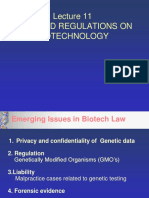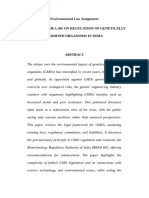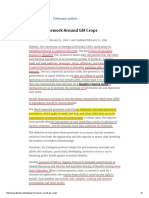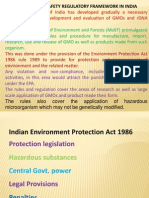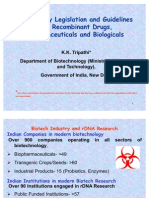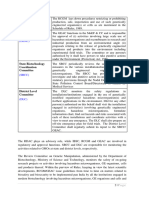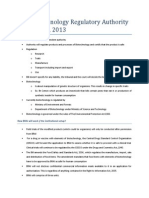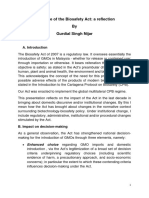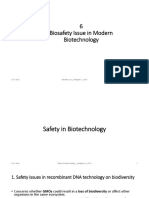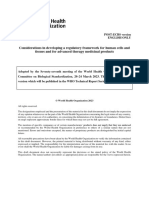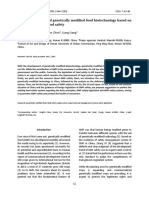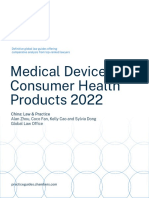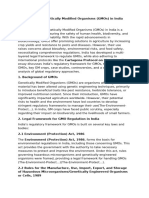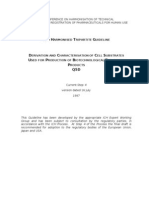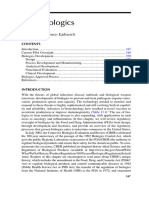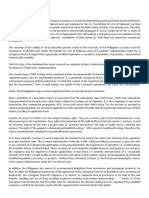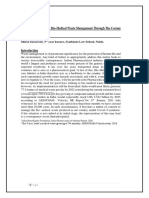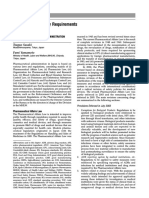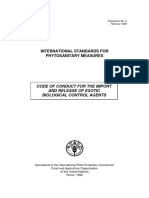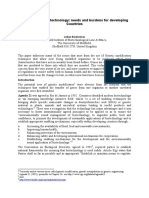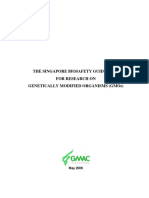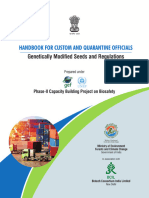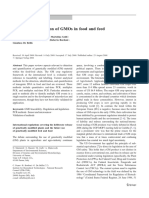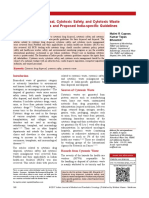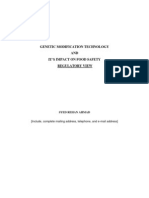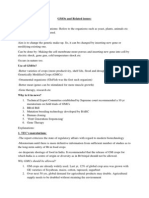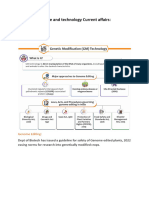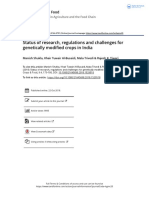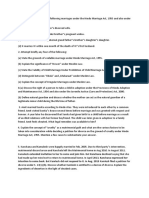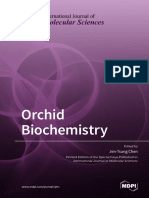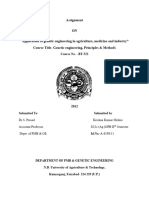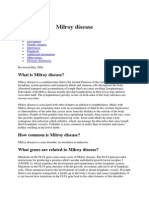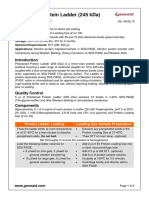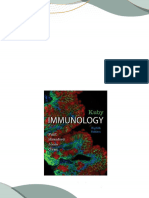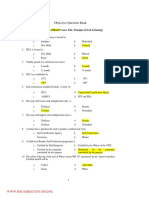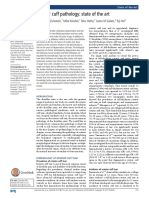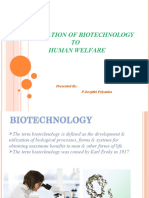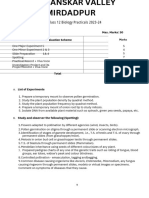Bhuvan Bhaskar Jha & Ashutosh Shankar - Civil
Bhuvan Bhaskar Jha & Ashutosh Shankar - Civil
Uploaded by
monty singhCopyright:
Available Formats
Bhuvan Bhaskar Jha & Ashutosh Shankar - Civil
Bhuvan Bhaskar Jha & Ashutosh Shankar - Civil
Uploaded by
monty singhOriginal Description:
Original Title
Copyright
Available Formats
Share this document
Did you find this document useful?
Is this content inappropriate?
Copyright:
Available Formats
Bhuvan Bhaskar Jha & Ashutosh Shankar - Civil
Bhuvan Bhaskar Jha & Ashutosh Shankar - Civil
Uploaded by
monty singhCopyright:
Available Formats
Vol.
2 Jamia Law Journal 2017
EVALUATING THE LAW ON REGULATION OF
GENETICALLY MODIFIED CROPS IN INDIA
Bhuvan Bhaskar Jha & Ashutosh Shankar*
1. Introduction
The debate over the coterminous effects of genetically modified organisms on the
environment has been raging on in the recent years both in India and the international
arenas. In the past decade alone, there has been a substantial rise in the number of
groups that take a stand against the release of such organisms into the food chain. This
opposition to the development and sale of genetically modified organisms has been, to
date, successfully countered by the lobbying juggernaut of the major players in the
genetic engineering industry who seek to capitalise on the established advantages of
such organisms like higher yielding capacity and higher resistance to pests and diseases
in the case of genetically modified agricultural crops.
The propaganda against and in support of genetically modified organisms is dangerous
as it leads to the formation of an extremely reductionist view of the issue in the eyes of a
layman who either sees the strictly against or staunchly for stance of the interest groups
involved. Education regarding the existence of a common ground between the two
stands needs to be imparted. It has become an imperative objective to inform the
layman about the credible advantages and potential disadvantages of introducing a
product of human intervention in the process of evolution and natural selection.
The primary objective of this paper is to present an overview of the law on regulation
and release of genetically modified organisms. A brief discussion about the existing
legislations has been attempted which is followed by a concise account of the functions
of the regulatory committees on GMOs. An account of the associated liabilities and
remedies that flow with the GMOs and transgenic products has also been provided. The
precautionary principle which forms the backbone of the machinery deciding the
deployment of precautionary action has also been elucidated. Lastly, with a forward
looking perspective the merits and lacunae of the Biotechnology Regulatory Authority
of India Bill has been explained with recommendations proposed for the emendation of
the Bill.
India’s current legislative framework with regard to genetically modified organisms is
arguably panoramic with statutes spanning the fields of science and technology,
environment and its preservation, agriculture and its advancement, food and health
119
Published in Articles section of www.manupatra.com
Evaluating the Law on Regulation of Genetically Modified Crops
and also the trade of GMOs. Almost all the frameworks dealing with the regulation of
GMOs have been briefly discussed in the following part of the paper. The only
exceptions worth mentioning are the Patent Act, Biological Diversity Act, and Plant
Variety Protection and Farmers’ Rights Act which are remotely linked to the issue at
hand but do not have the machinery expressly concerned with the regulation and
release of GMOs.
2. Framework of Legislations
The regulations pertaining to biosafety in India constitutes primarily of the biosafety
rules and guidelines. However, the central legislative authority for biosafety regulations
in the country is arguably the Environment (Protection) Act, 1986.1 The sections 6, 8 and
25 of this Act jointly form the preamble through which all the currently existing
biosafety regulations flow in India. Section 6 of the Act gives the authority to the
Central Government to form the essential rules on the standard procedures, implement
safeguards and place the necessary restrictions for handling of hazardous substances
and outright prohibit the others. On the other hand, Section 8 of the Act imposes a
prohibition on a person from handling any substances considered to be hazardous
under the Act except when the procedures and safeguards have been complied to.
Lastly, the Section 25 of the Act places the responsibility of stipulating the rules
regarding procedures and safeguards for handling hazardous substances2 on the
Central Government. As a direct consequence of this, the general consensus in the
Indian Judicial System is that the biosafety rules are of a statutory nature as their
genesis lies in the abovementioned provisions of the Environment (Protection) Act.
These abovementioned provisions have also lead to the promulgation of the 1989
Biosafety Rules by the Ministry of Environment and Forests.3
The 1989 Biosafety Rules apply to the products made from genetically engineered
micro-organisms and other gene-technology produce and regulates their manufacture,
storage and import. These Rules also cover the pre-release facet of genetically modified
organisms, namely their research and development besides the large scale applications
and trials. Hazardous organisms which are not genetically modified are also regulated
by the 1989 Biosafety Rules. The Rule 8 of this statute mandates the requirement of an
approval by the regulatory bodies prior to the discharge or even the production of
*
Students, National University of Study and Research in Law, Ranchi
1
The Indian Environment (Protection) Act, 1986 (Act 29 of 1986).
2
Ibid.
3
Rules for the Manufacture, Use/Import/Export and Storage of Hazardous Micro Organisms/Genetically Engineered
Organisms or Cells. (Rules 1989).
Published in Articles section of www.manupatra.com
Vol. 2 Jamia Law Journal 2017
genetically modified organisms and cells. The Rules no. 10 and 11 necessitates the
requirement of an approval for any such substances that contain genetically engineered
organisms or even cells. However, the Rule 9 of this statute is the foremost in
significance as it expressly prohibits the deliberate and/or unintentional discharge of
genetically modified organisms (for experimental purposes) covered under its schedule,
barring a situation where it has been approved as a ‘special case’ by the appropriate
authority. The abovementioned schedule is a feature of the 1989 Biosafety Rules which
classifies human and animal pathogens in terms of their risk profiles.
The 1989 Biosafety Rules have been augmented aptly by the Biotechnology Safety
Guidelines which have been put into effect by the Department of Biotechnology.4 The
Biotechnology Safety Guidelines are the consequence of Rule 4(2) of the 1989 Biosafety
Rules which mandates the requirement of guidelines manuals which are to be
stipulated by the Review Committee on Genetic Manipulation. This committee is a
departmental off-shoot of the, and serviced by the Department of Biotechnology. These
guidelines are concerned with the assessment of biosafety levels of which it carries a
detailed analysis. A detailed admonishment on recombinant DNA or rDNA related
activities, experiments, shipments and quality control produced by genetic engineering
is also provided. The Biotechnology Safety Guidelines, before reaching its current form
and after being issued by the Department of Biotechnology in 1990 were revised and
emended two times and finally amended in 1998 in accordance with the progressive
strides made in the field of rDNA research.
3. .Regulatory Committees
Typically, there are four stages of departmental structures involved in the life-cycle of a
genetically modified organism or of a GMO based product. These are the pre-research,
research, release and post-release stages. The pre-research stage is monitored by the
Recombinant DNA Advisory Committee as it is the body which authorises and
approves the research to be undertaken. The release stage in the life-cycle of a GMO is
governed by the Review Committee on Genetic Manipulation and the Genetic
Engineering Appraisal Committee. The RCGM reviews the procedure of research and
experiment-based releases whereas the commercial discharge of GMOs directly or
indirectly, is monitored by the GEAC. The occupants of the post-release stage are the
Monitoring and Evaluation Committee, the State Biotechnology Co-ordination
Committee and the District Level Committee. Although, these committees tend to
overlap into the research stages as well through data-provisioning submitted to the
4
Revised Guidelines for Research in Transgenic Plants and Guidelines for Toxicity and Allergenicity Evaluation,
1998.
121
Published in Articles section of www.manupatra.com
Evaluating the Law on Regulation of Genetically Modified Crops
RCGM. Lastly, the Institutional Biosafety Committee implements the standard
safeguards at the research and development sites under the headship of the RCGM, the
SBCC and the DLC. A brief description of the undertakings of the respective
committees is elucidated below.
Recombinant DNA Advisory Committee (RDAC)
The Department of Biotechnology is the parent body of this committee. The committee
bears the responsibility of studying and reviewing the changes and developments made
in the field of biotechnology at the national and international arenas. Consequently, it
renders apposite suggestions to enhance safety regulations in the area of recombinant
research and their applied utilities.
Review Committee on Genetic Manipulation (RCGM)
Just like the RDAC, this committee is also monitored and constituted by the
Department of Biotechnology. However, this committee concerns itself with the safety
and precautionary aspects of research in genetic engineering. In order to ensure the
same, the committee has to stipulate the specific guidelines regarding the activities
involving genetic engineering of organisms and their consequent use or release. The
utmost importance is given to its prime objective which is to ensure environmental
safety. It also bears the responsibility of monitoring the products, field experiments,
production, sale and shipment involving even a fraction of genetically engineered
organisms and cells which are classified as so in the schedule.
Institutional Biosafety Committee (IBSC)
The duty of constituting the IBSC lies with the institution which is conducting a
research that includes the usage of even the smallest proportion of genetically modified
organisms and even microorganisms that aren’t natural to the local conditions. This
committee needs to be comprised of the head of the parent institution directly invested
in the research, the scientists hired by the institution for the genetic engineering of
organisms, at least one medical expert and one nominee of the Department of
Biotechnology. The parent institution is required to prepare an up-to-date emergency
procedure(s) with the aid of the IBSC which conforms to the guidelines of the RCGM. It
is also imbibed with the duty of providing the copies of such a contingency plan and
procedure to the District Level Committee and the Genetic Engineering Appraisal
Committee.
Published in Articles section of www.manupatra.com
Vol. 2 Jamia Law Journal 2017
Genetic Engineering Appraisal Committee (GEAC)
The GEAC is constituted by the Ministry for Environment and Forests and grants the
requisite approvals for activities or procedures involving large-scale commercial use
and discharge of potentially hazardous microorganisms not excluding any such import
comprising of GMOS and recombinant DNA. This committee has the authority to
prohibit the production, sale, shipment or use of GMOs if it deems it a threat to the
environment.
State Biotechnology Co-ordination Committee (SBCC)
The SBCC is constituted by the respective State Governments of India and acts as the
State nodal agency monitoring and assessing the damages caused by the release of
genetically modified organisms. The SBCC yields the power to enforce punitive action
against the violations after it has conducted an appropriate investigation. This
committee bears the additional responsibility of periodically reviewing the safety and
control measures employed by the industries or institutions invested in the occupation
of handling genetically modified organisms and hazardous microorganisms.
District Level Committees (DLC)
The DLC is constituted at the districts where biotechnology projects are to be
undertaken. Its authority is subject to that of the SBCC. The head of the DLC is the
District Collector and it is him who reviews and assesses the safety regulations
employed by the industries or institutions engaged in the use of GMOs or hazardous
microorganism. The committee’s responsibilities include the checking of the
institution’s compliance with recombinant DNA guidelines and reporting the
violations, if any, to the SBCC or the GEAC. It needs to coordinate the activities of the
concerned institution or industry to the effect that it becomes easier to contain
emergency situations caused from accidental or even intentional discharges.
Monitoring and Evaluation Committee
This committee has the duty of undertaking regular visits to the sites of experiment and
recommend procedures in case any remedial measure is required to adjust any potential
threat from discharges. The committee also aids the RCGM in tabulating and analysing
primary data from the field so as to ascertain the comparative agronomic advantages of
genetically engineered crops or plants.
4. Legal Disputes
123
Published in Articles section of www.manupatra.com
Evaluating the Law on Regulation of Genetically Modified Crops
In the case of Research Foundation for Science, Technology and Natural Resource Policy v.
Union of India5, the petitioners alleged that the respondents had violated certain
provisions of the Indian biosafety regulations. The alleged violations stemmed from
genetically modified cotton seeds which were imported and had subsequently spread
through trials which had been conducted on multiple sites in open environment. It was
also alleged that the respondents were not adhering to the adequate measures for
countering pollen flow or maintaining a safe distance. The Supreme Court barred any
further field trials by issuing a temporary injunction against the respondents and
concurrently directed them to make amendments which had the effect of securing
against any potential threats to biodiversity, environment and human health.
Accordingly, the Department of Biotechnology responded by authorising the Review
Committee on Genetic Manipulation to conduct small-scale field trials. The petitioners
aggrieved by this approached the appellate authority constituted under Rule 19 of the
1989 Biosafety Rules by challenging the approval of Bt Cotton. This appeal was
dismissed and it was held that the approval of the Bt Cotton was granted after due
examination of the biosafety and agronomic data collected via tests over a period of six
years. The allegation directed against the permission granted by the Review Committee
on Genetic Manipulation as being violative of the 1989 Biosafety Rules was dismissed as
RCGM has the authority to permit restricted field trials to control and prevent the
escape of GMOs into the environment. It was reiterated that in accordance with the
Allocation of Business Rules, 1961, the Department of Biotechnology is the central
department to monitor and regulate the import and shipment of genetically modified
organisms.
A public interest litigation filed before the Supreme Court by Gene Campaign in 2004 is
pending under the head of Gene Campaign v. Union of India.6 The petition challenges the
constitutional validity of the 1989 Biosafety Rules and attacks its utility and alleges that
the rules are inconsistent with their intended objective of protecting the environment
and public health guaranteed by the Article 21 of the Constitution of India. It is also
alleged that the 1989 Biosafety Rules are not in conformity with the Biosafety Protocol
of which India is a signatory and has ratified. The petitioners claim that the regulatory
agencies under the 1989 Biosafety Rules lack technical competence, transparency, and
public participation. It is further alleged that many important and legally established
notions like the precautionary principle, inter-generational equity and polluter pays
principle have not been accrued with due recognition under the rules.
5
(2005) 13 SCC 186.
6
Writ Petition (Civil) No. 606/2007.
Published in Articles section of www.manupatra.com
Vol. 2 Jamia Law Journal 2017
5. Genetically Modified Organisms and Associated Liabilities
Presently, there does not exist any specialised statute that deal with genetically
modified organisms and the liabilities arising out of the misappropriate handling or use
of such organisms in India. However, there exists effective legal machinery that ensures
the awarding of appropriate legal remedies to the aggrieved persons. Instances where
damage and injuries caused by the misapplication of genetically modified organisms
and violation or oversight of any biosafety regulation can be discerned with the aid of
specific legal provisions and precedents of the judiciary.
Specific GMO Liability Provisions
If a measure adopted by the defendants is found to be in contravention of the 1989
Biosafety Rules, then the section 15 of the Environment (Protection) Act, 1986 is
attracted. Such a failure to concur with the Biosafety Rules is punishable by an
imprisonment term extending to not more than five years or a fine not extending the
amount of one Lakh rupees or both. An additional fine can be imposed if such a
contravention of the Biosafety rules continues and this amount shall not exceed five
thousand rupees for every day.7 The court has the authority to take cognizance under
section 15 of the Environment (Protection) Act, 1986 only on a complaint instituted by
either the central government or an officer authorized on its behalf and even a person
who has given a due notice of a minimum of sixty days in the prescribed manner to the
central government or a authorised officer.8 However, the general consensus regarding
the liability provisions under the Act is that they are tenuous and time consuming.9
Any genera or species that involve the use of ‘any technology’ which makes them
potent to either the life or health of human beings, animals and plants cannot be
registered under the Protection of Plant Varieties and Farmers' Rights Act, 2001.10 The
explanation of the sub-section clarifies that the term ‘any technology’ includes the
genetic use restriction and terminator technology. The Environment (Protection) Act,
1986 deals specifically with the liability arising from the non-performance of a
propagating material that is registered under the Act. The developers of such varieties
are duty-bound to make a disclosure to the farmers about the expected performance
under differential conditions. Upon the failure of the developers to do so, the aggrieved
7
Punishment, which may extend up to seven years, is prescribed, if such failure or contravention continues beyond
one year from the date of conviction.
8
Sec. 19, The Indian Environment (Protection) Act, 1986 (Act 29 of 1986)
9
R.K. Tyagi, Randhawa GJ, et.al. (eds.), Transgenic Crops and Biosafety Concerns (NBPGR, New Delhi, 2001)
10
The Indian Environment (Protection) Act, 1986 (Act 29 of 1986), s. 29(3).
125
Published in Articles section of www.manupatra.com
Evaluating the Law on Regulation of Genetically Modified Crops
farmers can institute a suit for damages before the Plant Variety Protection Authority
under the Act11, which has the authority to award compensations accordingly.
General Environmental Liability
The Articles 32 and 226 of the Constitution of India are the legal pathways through
which the fundamental rights guaranteed under part III of the Constitution can be
enforced by any qualified citizen or a legal person under certain cases. The Article 32 is
invoked to move the Supreme Court and likewise Article 226 is invoked to move any
particular High Court12 under the jurisdiction of India. Both of these courts are clothed
with the power to issue appurtenant writs for the enforcement of fundamental rights
and as a remedial measure for their infringements. The apex court has by way of its
pronouncements, which have had the effect of considerably relaxing the rule of locus
standi, has onset a plethora of public interest litigations seeking to enforce the
fundamental rights of the socially and economically handicapped who were previously
inept to approach the courts. Furthermore, the increasingly broadening horizon of the
interpretations under the head of Article 21 has brought to the fore previously
unimportant rights like the right to a clean environment and the right to health. This
has further enabled persons to approach the High Courts or the Supreme Court for the
remedy of the violations of such rights. The remedial measures employed by the courts
involve the closure of polluting establishments and mandatory requirement of caution
deposits, following the final report of fact-finding commissions constituted by the
respective courts. A number of judicial pronouncements have emphasized the
requirement of establishing specialised ‘environmental’ courts across the nation to
handle the complicated issues with expertise.13 The environmental liability principles
are primarily built up on Supreme Court judgments like the precedent of M.C. Mehta v.
Union of India14. In this case, the apex court examined the absolute and strict liability of
enterprises in the event of an accident particularly if the respondent is engaged in
hazardous or inherently dangerous industry. The court also examined the rule laid
down in the Ryland v. Fletcher15 case and was of the opinion that this rule was archaic as
it was promulgated in a period when science wasn’t as developed and hence this
precedent was inept for accounting the “present day economy and social structure”.
Consequently it was held that an enterprise that causes harm as a result of any accident
11
The Indian Environment (Protection) Act, 1986 (Act 29 of 1986), s. 39(2)
12
The jurisdiction of High Court is not limited to the protection of fundamental rights but also for other legal rights.
13
Law Commission of India, 186th Report on Proposal to Constitute Environment Courts (September, 2003).
14
1987 SCR (1) 819
15
(1868) UKHL 1.
Published in Articles section of www.manupatra.com
Vol. 2 Jamia Law Journal 2017
is strictly and absolutely liable to compensate the affected. This liability16 was held to
not be subjected to the exceptions allowed under the Ryland v. Fletcher rule.
As regards the factor of accounting for the amount of damages to be paid by the
violating enterprise, it has become an established practice to keep the amount payable
to be directly proportional to the capacity and wealth of the violators. The objective for
awarding a compensation of such a nature is to create deterrence among the enterprises
handling hazardous substances. In Union Carbide Corporation v. Union of India17 the
Supreme Court dismissed the precedents set in the Oleum Gas Leak case as obiter dicta
citing the fact that a conclusion about the status of the defaulting company under
Article 12 of the Constitution was not drawn. However, the apex court adopted a
different point of view while deciding in the matter of Indian Council for Enviro-Legal
Action v. Union of India18. It was observed by the Hon’ble court that although the court
hadn’t directed any specific damages to be paid in the Oleum Gas Leak case, the bench
had dictated that cases on the basis of the principle of absolute liability can be
instituted. Therefore, the apex court in the Indian Council for Enviro-Legal Action case
followed the principles of absolute liability in discerning the immediate issues of the
matter. Concurrently, it was also observed by the court that damages based on the
absolute liability principle must account for the costs of restoring the environmental
degradation besides the compensation for the victims. On the other hand, in M.C. Mehta
v. Kamal Nath19, the perspective adopted by the Supreme Court was to view pollution as
a tortious act against the ‘community as a whole’. The court also awarded exemplary
damages to be paid by the respondent. Thus, it can be reasonably inferred that the
guilty party is liable to pay damages to the victims who have suffered loss and the same
should also account for the restoration of the ecology and environment. A classification
of different types of liabilities associated with pollution was attempted by the Supreme
Court in the case of K.M. Chinnappa v. Union of India20. The court categorized the
liabilities as follows: (i) criminal liabilities through which imprisonment sentences can
be awarded; (ii) administrative sanctions; (iii) costs for clean-up of the pollution caused;
(iv) civil liability based on the principle of strict liability; and (v) adverse publicity. In
the case of Research Foundation for Science Technology and Natural Resources Policy v.
Union of India21, the polluter pays principle was further clarified by the Supreme Court.
16
The Public Liability Insurance Act, 1991 (Act 6 of 1991).
17
1990 AIR 273.
18
AIR 1996 SC 1446.
19
(1997)1 SCC 388.
20
AIR 2003 SC 724.
21
(2005) 13 SCC 186.
127
Published in Articles section of www.manupatra.com
Evaluating the Law on Regulation of Genetically Modified Crops
It was held that this principle includes the costs for preventing and tackling any
pollution caused by the polluter.
Liability under Law of Tort
The liability under law of tort, in majority of the cases, can be traced to the pernicious
effects which result from mixing of genetically modified organisms with unmodified or
‘natural’ organisms22 and even due to the supplanting of genetically modified plants as
substitutes or volunteers. However, given that pollen transfer is a biological
phenomenon, in order to determine liability, some discernable damage needs to be
proved. To date, no specific precedents have been established in India. Thus, reliance
can be made on analogical deduction from trends set in the United States and Canada.
These trends show that suits have been instituted by non-transgenic plant growers
against the developers of genetically modified plants or crops. The genetically modified
crops hold an inherent potency of causing a genetic contamination that might onset
claims of nuisance, negligence and strict liability against the farmers and the developers
of the seeds.23 Claims pertaining to trespass24, and nuisance25 based suits, have failed
thus far in both the American as well as Canadian courts. However, suits resulting from
negligence have found considerable success in establishing precedents and it has been
held that it is reasonable to expect a duty of care from persons handling genetically
modified organisms. A breach of that duty would invite liability on the basis of
negligence. Any economic loss resulting from physical contamination caused by the
adulteration of seeds by unapproved substances and loss of markets caused thereby are
valid claims for instituting suits on tort of negligence, private nuisance and public
nuisance as well.26
As many as five instances can be anticipated in United States of America and Canada
based disputes where genetically modified organisms related liability might come to the
fore. They are as follows: (i) damages arising from the admixture of GMOs with
conventional crops; (ii) damages originating from the loss of premium for a traditional
commodity or food products without GMOs; (iii) an admixture rendering the registered
identity of the product as lost; (iv) damage caused due to the loss of markets and (v)
22
A permissible limit of GMOs in non-GM grains is fixed in India by the GEAC.
23
Drew L. Kershen. ‘Of Straying Crops and Patent Rights’ 43 Washburn L.J. (2004)
24
Stuart J. Smyth and Drew L. Kershen, ‘Agricultural Biotechnology: Legal Liability Regimes from Comparative
and International Perspectives’ 6 GJA (2006)
25
Ibid.
26
Stuart J. Smyth and Drew L. Kershen, ‘Agricultural Biotechnology: Legal Liability Regimes from Comparative
and International Perspectives’ 6 GJA (2006).
Published in Articles section of www.manupatra.com
Vol. 2 Jamia Law Journal 2017
damage from inability of a farmer to plant a crop due to the proximity of transgenic
crops.27
GMOs and Product Liability
The genesis of the liability arising from products causing injury lies in the House of
Lords decision of Donoghue v. Stevenson.28 It was held that the manufacturer of a
product owes a duty of care towards the consumer when he has the knowledge that
there does not exist any intermediate mechanism for the examination of the
manufactured product and that an omission of reasonable care on his part towards the
product can cause injury to the consumer’s life or property or both.29
The Consumer Protection Act, 1986
The central objective behind the promulgation of this Act was to promote and protect
the consumer’s rights in the market. The consumer rights include but are not limited to
the right to be shielded from the marketing of potentially hazardous goods; right to be
informed about the quality, quantity, purity, standard and price of goods and the right
to consumer education. Under the Act, all movable properties with the exception of
actionable claims and money bills are considered goods.30 Therefore, genetically
modified organisms based products are also considered as goods under the Act. The
Act also provides for a consumer31 to file a complaint32 against a trader33 for defects in
the goods sold or for the deficiency in service accompanying the sale of goods. Thus,
actions against defective GMOs or the inept services accompanying them are
maintainable under the Act. Suits34 can also be instituted against the malpractices of
excessive pricing, offering sale of hazardous or potentially hazardous35 goods and
services. Restrictive trade practices36 that could lead to the manipulation of prices and
unfair conditions of delivery, which in turn can cause unjustified costs and restrictions
for the consumer, are also covered by the Act. Fraudulent or bogus claims aimed at
deceiving the consumer by misrepresenting goods and services, fall within the ambit of
27
Ibid.
28
(1932) UKHL 100.
29
Ibid.
30
The Section adopts the definition in the Section 2(7) of Sale of Goods Act, 1930 (Act 3 of 1930).
31
Sec. 2(1) (d), The Consumer Protection Act, 1986 (Act 68 of 1986)
32
Sec. 2(b), The Consumer Protection Act, 1986 (Act 68 of 1986)
33
Sec. 2(j), The Consumer Protection Act, 1986 (Act 68 of 1986).
34
Sec. 2(c), The Consumer Protection Act, 1986 (Act 68 of 1986)
35
The trader in such cases could have known with due diligence that the goods offered for sale are unsafe.
36
Delay in the agreed delivery time leading to a price rise and any trade practice which requires the buying of any
goods or hiring or availing of any service as a condition precedent for buying other goods and hiring or availing
other services’, are restrictive trade practices.
129
Published in Articles section of www.manupatra.com
Evaluating the Law on Regulation of Genetically Modified Crops
the Consumer Protection Act, 1986. Such a contrived representation of the standard,
grade and composition of genetically modified organisms are considered to be unfair
trade practice. Therefore, the marketing of GMOs without the labels indicating their
grade and composition, especially when a legal requirement to label the GMOs exists,
tantamount to a fallacious and bogus representation and is consequently an unfair trade
practice prohibited by the Act.
6. Procedure for Large Scale Field Trials and Risk Assessment
If the volume of the product to be assessed contains GMOs and exceeds twenty litres,
then the trial is said to be on a ‘large-scale’. There are standard procedures and
safeguards prescribed by the law for regulating large-scale field trials of genetically
modified organisms. The host organism (which contains GMOs) and the genetically
modified organism itself should not be pathogens and should not have a nature similar
to pathogens. The vector chosen for the experiment should be secured enough to be
contained and safe. For the execution of an environmental release, the geographical
position of the site, the dimensions of the area, the expected effects on the ecosystem in
the proximity of the site, the method and quantity of the release and contingency plans
need to be made out prior to the release. Assessment of the risks associated with the
release needs to be made on a case-by-case basis before the release.37 The Genetic
Engineering Appraisal Committee bears the duty of handling and monitoring all large-
scale operations involving GMOs.38 The applicant has to submit his operational details
on the management and disposal of harmful wastes before the GEAC. The evaluation of
the genetically modified organism in a laboratory, growth chamber and an atmosphere
stimulating greenhouse conditions is a pre-requisite to the field trials. Secure measures
need to be employed so as to guarantee the safety and to prevent an accidental
discharge of the GMOs. It is a reasonable expectation that the enterprise conducting the
field trial either destroys or neutralises the bio-wastes before disposing them into the
environment. The maintenance of a safe isolation distance, growth of any incompatible
crop beyond the isolation distance to asses pollen transfer, growth of a few layers of a
similar and preferably the same non-transgenic crop beyond the isolation distance as a
neutralizer for escaped pollen are a few more prescribed measures to ensure safety of
genetically modified plants testing. Following the harvest of such GM plants, the
destruction of any vegetative parts or any plants generated from the GM seeds is a
37
Recombinant DNA Safety Guidelines, 1990.
38
The GEAC, polices Biosafety Research Level 11 (BRL11) trials
Published in Articles section of www.manupatra.com
Vol. 2 Jamia Law Journal 2017
standard recommended practice. To further ensure the absence of any leftover, viable
genetically modified cells, cultivation on that land is prohibited for a year. 39
Risk Assessment for Releases into the Environment
In order to properly asses the risks before the release of GMOs into the environment,
certain factors need to be considered. These include the nature of the GMO, the
particulars of the organism’s modifications, its genetic stability for its long term
survival, and the details of the organisms targeted by the GMOs. Also accompanying
should be the knowledge of the known and expected effects of the genetically modified
organism. An experimental field use permit needs to be obtained from the Genetic
Engineering Appraisal Committee. The GEAC will audit and evaluate the safety control
measures and monitor the controlled large scale releases40. The GEAC will subsequently
submit the information to the Review Committee on Genetic Manipulation 41. In order to
ascertain the possible risks associated with the release, factors like the characteristics of
the donor organism, the vector, the transgenic insert, the genetically modified organism
and the method of modification would be considered42.For the evaluation and
management of risks associated with limited releases, the maintenance of an isolation
distance43 (which will prevent fertilization), prevention of the plant developing buds by
human intervention and through biological means are advised. Other additional
suggestions include the destruction of volunteer plants and isolating the allergen
properties of the GMO, drafting of emergency plans44 and documentation of prior
information.45
Precautionary Principle and Precautionary Approach
The precautionary principle is a heuristic doctrine through which pragmatic resolutions
can be made in situations of scientific uncertainty. There are four primary objectives of
the precautionary principle: (i) enforcement of preventive measures in situations of
scientific uncertainty; (ii) transpose the burden of proof on the exponents of an
inherently harmful activity; (iii) probe for the alternative procedures to achieve the
same goal and (iv) involve the invested participants in the decision making process.46
39
Recombinant DNA Safety Guidelines, 1994.
40
Safety, risks and accidents related with environmental release.
41
Recombinant DNA Safety Guidelines, 1990.
42
Protocols for Food and Feed Safety Assessment of Genetically Engineered Crops, 2008.
43
Guidelines for the Safety Assessment of Foods derive from Genetically Engineered Plants, 2008.
44
Ibid.
45
Revised Guidelines for Research in Transgenic Plants and Guidelines for Toxicity and Allergenicity Evaluation,
1998
46
David Kriebel et.al., ‘The Precautionary Principle in Environmental Science’, 109 Environ Health Perspect 871
(2001).
131
Published in Articles section of www.manupatra.com
Evaluating the Law on Regulation of Genetically Modified Crops
However, the practical projections of the principle’s objectives remain controversial due
to their varied interpretations.47 Numerous versions of the principle continue to exist
and essentially two formulations of the principle exist in International law- the
precautionary approach and the precautionary principle.
Principle 15 of the Rio Declaration, 1992 states regarding this principle: “in order to
protect the environment, the precautionary approach shall be widely applied by States
according to their capabilities. Where there are threats of serious or irreversible damage,
lack of full scientific certainty shall be not used as a reason for postponing cost-effective
measures to prevent environmental degradation.” The articulation of the approach is
similar to that of the principle and the only variance exists in that firstly, the Rio
Declaration recognises that there may be differences in local capabilities to apply the
approach and secondly, that it appeals for the accounting of economic and social costs.48
It is a general consensus that this ‘approach’ is a dilution of the more stringent
‘principle’
Precautionary Principle in International Law
The Cartagena Protocol on Biosafety to the Convention on Biological Diversity has
promulgated one of the most robust references to the precautionary principle in
contemporary international law. The protocol is the first of its kind to expound the
precautionary principle outside of its preamble i.e., delineate the principle in its
operational titles. As a consequence of this the Protocol has been credited with
“propelling the precautionary principle to the forefront of international environmental
law”.49
The precautionary principle firstly dictates the requirement of a minimum level of risk
that warrants the application of precautionary action. Enterprises that deal with even
remotely risky yet economically profitable activities often employ “higher risk-
triggering levels”. The Rio Declaration requires the existence of both threats of serious
and of irreversible damage to onset a precautionary action. Whereas, the level of risk
established by the Protocol is “potential adverse effects”, which tends to be significantly
lesser than the levels established in the Rio Declaration. Thus, the inference that
precautionary action is much easily justified under the Protocol than the Rio
47
Anne I. Myhr, ‘The Precautionary Principle in GMO Regulations’, T. Traavik and L.C. Lim (eds.), Biosafety First
Chapter 29 (Tapir Academic Publishers, 2007)
48
S.M. Garcia, ‘The Precautionary Principle: its Implications in Capture Fisheries Management’ 22 Ocean Coast
Manage 99 (1994).
49
David J. Schnier, ‘Genetically Modified Organisms and the Cartagena Protocol’ 12 Fordham Envtl. L.J. 377
(2001).
Published in Articles section of www.manupatra.com
Vol. 2 Jamia Law Journal 2017
Declaration holds true. Secondly the Protocol makes an allowance to the responsible
party during a period when precaution is triggered by making a “decision as
appropriate with regard to import in order to avoid or minimize such potential adverse
effects”. More importantly, the Protocol does not seek any considerations for the profits
of an activity or its economical quality. By doing so, the Protocol allows for the focus on
the potential harmful impacts on the biodiversity. Thirdly, and in stark contrast to the
Rio Declaration’s requirement of “lack of full scientific certainty”, the Protocol only
demands the “certainty” for the conjuring of the precautionary principle. This renders
the need for scientific consensus before the invocation of precautionary principle mute.
Furthermore, the Protocol also necessitates the need for subjecting the decisions made
to the assessment of risk.
Article 15(3) of the Protocol states that parties may ask the exporters to carry out the
requisite risk assessments which will consequently enable the developing economies of
the world to promulgate measures constituted on the precautionary principle, even in a
situation where they do not possess the administrative machinery to perform those risk
assessments themselves.
Although the Protocol does not mandate the requirement of scientific knowledge and
consensus for taking precautionary action, this should not be construed as the existence
or non-existence of a risk. Notwithstanding such articulation in the Protocol, risk
assessments are to be conducted on a case-by-case basis and in a manner that conforms
to the principles and laws of the associated science.
In postlude it can be summarised that the Precautionary Principle has an ambiguous
language which makes it difficult to discern the acceptable levels of risks, how such
potentially harmful trade-offs should be addressed, and what measure of scientific
evidence is adequate in deriving at decisions.
Precautionary Principle in India
The precautionary principle is not promulgated by any explicit statutory authority in
India. The resulting lacunae in biosafety regulations is however supplanted by judicial
pronouncements of the Supreme Court which has adopted the matrix of the principle in
adjudicating legal disputed regarding genetically modified organisms. In Vellore
Citizens’ Welfare Forum v. Union of India50, the polluter pays principle and the
precautionary principles were held to be indispensible parts of promoting sustainable
development in India. The precautionary principle from the perspective of municipal
50
AIR 1996 SC 2715
133
Published in Articles section of www.manupatra.com
Evaluating the Law on Regulation of Genetically Modified Crops
law would suggest that: (i) authorities have to ‘anticipate, prevent and attack the causes
of environmental degradation’; (ii) no postponement of cost effective measures in the
face of scientific uncertainty and irreversible consequences; and (iii) the proponent
bears the burden to prove that a proposal is environmentally friendly. 51
The apex court was of the opinion that even though the principle is not promulgated by
any Articles of the Constitution of India or any other of the several environmental
legislations, it can be incorporated into the domestic law as a cardinal principle of
international environmental law which is not contrary to municipal laws and should be
taken into account for deciding cases by the judiciary. 52
In another case53 it was held by the Hon’ble court that reversal of the burden of proof,
good governance and principle of intergenerational equity are indispensible ingredients
of the precautionary principle. The Supreme Court while deciding the case of Narmada
Bachao Andolan v. Union of India54 held that the precautionary principle needs to be
followed in all cases of uncertainty of ecological effects. Conversely, if the effects are
certain or are known, mitigating steps should be employed to contain the harmful
quality as much as possible. It was also established that a mere change in the ecology55
should not be equated with an ecological disaster and that to counter such a claim, the
defendant will need to prove the inert nature of the activity.
7. Recommendations on BRAI Bill
The Government of India has in conformity with the provisions of the Cartagena
Protocol, of which it is a signatory, proposed the promulgation of National
Biotechnology Regulatory Authority through the Biotechnology Regulatory Authority
of India Bill which will, subsequent to its establishment, be the supreme authority on
regulations and policies that flow with the genetically modified organisms in India. The
Bill proposing BRAI is yet to be passed by the parliament. However, it has met with
severe oppositions from the farmers and non-governmental organisations like
Greenpeace India due to several of its questionable provisions that encroach upon the
legal rights of the farmers and the consumers generally. It is submitted that these
51
Ibid.
52
It was reiterated that the principle is a customary rule of international law status of the principle and part of the
Indian law {Research Foundation for Science Technology National Resource Policy v. Union of India, (2005) 13
SCC 186}. ·
53
A. P. Pollution Control Board v. Prof M. V. Nayudu, 1999(2) SCC 718.
54
AIR 2000 SC 3751.
55
Here the activity was the construction of a large dam. The Court refused to equate dams with a nuclear
establishment or polluting industry, by commenting that there has been an environmental upgradation with the
construction of a dam.
Published in Articles section of www.manupatra.com
Vol. 2 Jamia Law Journal 2017
conflicting provisions of the Bill be emended and alternate measures be taken to ensure
the prevention of such gross violation of constitutional and legal rights. A brief account
of the controversial provisions and their repercussions has been discussed below.
BRAI is abrogating the powers of the State Legislature
Section 2 of the bill avers that the Union or the parliament alongside the central
government has the authority to take actions pertaining to the regulation of genetically
modified organisms and associated products. In addition to Section 2 of the bill, Section
81 reinforces the stance of the former by stating that even if such an empowerment of
the Union is found to be in conflict with any previously existing legislation, the law
under the Section 2 will prevail. Such provisions are explicitly against the Constitution.
The Constitution expressly states that the parliament cannot legislate on matters
enumerated in the State list without prior authorisation by the State Legislative
Assemblies.56 Item 14 of the State List (List II) provides for the state legislative
assemblies to deal with matters concerning agriculture and plant diseases. 57
This goes to show that matters pertaining to the regulation of genetically modified
foods and products and their mass cultivation should be monitored by the state
legislature. Therefore, the provisions of the BRAI Bill are in contravention with the
Constitution as they override the powers of the state legislature.
Infringement of the Right to Information
Section 27(1) of the BRAI Bill states that the information pertaining to the research and
development of genetically modified organisms and transgenic foods and products
shall be confidential and will not be revealed in the public sphere. This is in direct
contravention to the Right to Information Act. The Right to Information Act, 2005 was
passed with the intention58 of keeping the citizens of India informed about the
machineries of the government and to counter corruption. This Act is a vital part of a
democracy as it promotes transparency and acts as a catalyst to hold the governments
and their agencies accountable to the public.
Legal Lacunae
Section 3 of the BRAI Bill59
states that the provisions of the Food Safety and Standards
Act, 2006, would no longer be applicable to the genetically modified organisms and
associated products covered by the Bill. This can lead to an extremely dangerous
56
Art. 249(1), The Constitution of India.
57
No. 14 of State List (List II): Agriculture, including agricultural education and research, protection against pests
and prevention of plant diseases.
58
The Right to Information Act, 2005 (Act 22 of 2005).
59
Schedule II, Part II of the National Biotechnology Regulatory Bill, 2008.
135
Published in Articles section of www.manupatra.com
Evaluating the Law on Regulation of Genetically Modified Crops
situation as the Food Safety and Standards Act provides for the explicit labelling of
genetically modified foods.
This oversight of an essential requirement can be catastrophic as there would no longer
be any legislation affirming the need for labelling genetically modified foods. This
would lead to a dire situation where the consumer, who will most likely be a layman,
would be rendered inept in differentiating between transgenic and organic food and
associated products. This is to be understood in the context of ‘labelling’ being the
operative part of the consumer’s ‘right to choose’.60
Cognizance of Offences and Lack of Jurisdiction
According to Section 70 of the Bill, all courts are universally barred from taking
cognizance of any offence punishable under the Bill except when a complaint has been
instituted by an authority or an authorised person under the Bill. Therefore, the
department set up by the Bill cannot be challenged unless the authority feels so, ergo,
they are answerable to themselves. In addition to this, the BRAI also establishes that
does not have the jurisdiction with respect to any matter which the appellate tribunal
under the Bill is empowered to decide.61 Further, no injunction can be granted by any
court in respect of any action taken under the Act.62 These provisions make the BRAI
Bill almost unimpeachable as very limited space is provided for interventions and the
conventional mechanisms have been completely dismantled. These issues are further
amplified by the free leash provided to the adjudicatory board to be established
through the Bill that will not be subject to the provisions of the Code of Civil Procedure,
190863 or the Indian Evidence Act, 187264. It is proposed that the board be regulated in
accordance with the principles of natural justice.65
8. Conclusion
India is a signatory to the Cartagena Protocol on Biosafety to the Convention on
Biological Diversity. According to this protocol, all signatories of the convention must
enact an explicit law dealing with the regulation and release of genetically modified
organisms. Keeping in conformity to this direction of the protocol, the Government of
India proposed the BRAI Bill which would most likely be the future of the legal and
administrative aspects of genetically modified organisms in India. However, as
60
Yves Bertheau (ed.), Genetically Modified and non-Genetically Modified Food Supply Chains: Co-Existence and
Traceability, (Oxford: Wiley-Blackwell, Oxford, 20th edn., 2013).
61
Sec.77, National Biotechnology Regulatory Bill, 2008.
62
Ibid.
63
Sec. 56(7), National Biotechnology Regulatory Bill, 2008.
64
Sec. 56(3), National Biotechnology Regulatory Bill, 2008.
65
Ibid.
Published in Articles section of www.manupatra.com
Vol. 2 Jamia Law Journal 2017
elucidated in the preceding section of this paper, such a governing body would be
extremely autocratic and almost unimpeachable. This conflict between the Bill and the
consumer’s rights has given rise to an undesirable situation; the resolution of which lies
in amending the aforementioned provisions of the Bill before it is passed by the
parliament. However, this prospective resolution is weakened considerably by the
lobbying forces of big industries that are heavily invested in transgenic technologies
which would exponentially benefit from the provisions of the Biotechnology Regulatory
Authority of India Bill. In such a situation, the farmer groups and anti-GMO activists
have approached the courts for recourse. While the suits against the Bill are pending, it
is submitted that such a piece of legislation should be declared ultra vires of the
provisions of the Constitution of India and a Bill which is more in line with the welfare
of the consumers and which conforms to the spirit of the Constitution be promulgated.
137
Published in Articles section of www.manupatra.com
You might also like
- Laws and Regulations On BiotechnologyDocument74 pagesLaws and Regulations On BiotechnologyAlkhair SangcopanNo ratings yet
- Bhadoriya Let AssignmentDocument26 pagesBhadoriya Let AssignmentUtsav SinghNo ratings yet
- Environmental Law AssignmentDocument21 pagesEnvironmental Law AssignmentPratha JainNo ratings yet
- Project Nidhi LL.MDocument2 pagesProject Nidhi LL.MshivendugaurNo ratings yet
- Legal Framework Around GM CropsDocument4 pagesLegal Framework Around GM Cropschitransh90No ratings yet
- Gmo in IndiaDocument6 pagesGmo in IndiaRohail KhanNo ratings yet
- Genetic Engineering by Appraisal Committee-1Document9 pagesGenetic Engineering by Appraisal Committee-1nandinipthorat00No ratings yet
- BiosafetyDocument12 pagesBiosafetyYogesh Banginwar0% (1)
- DR K K TripathiDocument39 pagesDR K K TripathisamiwalaNo ratings yet
- Biosafety GuidelinesDocument37 pagesBiosafety GuidelinesBhawna GautamNo ratings yet
- BSL2 and BSL3 and Certification-3Document5 pagesBSL2 and BSL3 and Certification-3dhirajsatyam98982285No ratings yet
- Biotechnology Regulatory Authority of India BillDocument5 pagesBiotechnology Regulatory Authority of India Billamarsinha1987No ratings yet
- A Decade of The Biosafety Act - A ReflectionDocument9 pagesA Decade of The Biosafety Act - A ReflectionNORASYIKIN BINTI AZHARNo ratings yet
- MODULE - V (B) DEBATABLE ISSUES OF BIOTECHNOLOGICAL INNOVATIONSDocument4 pagesMODULE - V (B) DEBATABLE ISSUES OF BIOTECHNOLOGICAL INNOVATIONSofficeNo ratings yet
- Biosefty Issues in Modern BiotechnologyDocument49 pagesBiosefty Issues in Modern Biotechnologymulatu mokononNo ratings yet
- Bio To NanoDocument6 pagesBio To NanodopauloNo ratings yet
- DBT..1990 Safety GuidelinesDocument13 pagesDBT..1990 Safety GuidelinesVijayakumar RajendranNo ratings yet
- INDIA Recombinant DNA Safety Guidelines and Regulations AnotherDocument9 pagesINDIA Recombinant DNA Safety Guidelines and Regulations AnotherilayahariNo ratings yet
- Unit VIDocument50 pagesUnit VISapna RaoNo ratings yet
- Biosafety and ELSIDocument8 pagesBiosafety and ELSIShaheen TajNo ratings yet
- WHO. Considerations in Developing A Regulatory Framework For Human Cells Tissue and ATMPDocument27 pagesWHO. Considerations in Developing A Regulatory Framework For Human Cells Tissue and ATMPwiwi ambarwatiNo ratings yet
- 06 - Enabling Regulatory Policy Globally Will Promote Realization of The Potential of Animal BiotechnologyDocument28 pages06 - Enabling Regulatory Policy Globally Will Promote Realization of The Potential of Animal Biotechnologysantirat.phoNo ratings yet
- Study On The Safety of Genetically Modified Food Biotechnology Based OnDocument8 pagesStudy On The Safety of Genetically Modified Food Biotechnology Based OnKelesha JohnsonNo ratings yet
- 2019 Genetically Modified Crops and Regulations in India - Myths Vs Facts, 2019Document30 pages2019 Genetically Modified Crops and Regulations in India - Myths Vs Facts, 2019ameerNo ratings yet
- 英文【环球律师事务所】医疗器械及消费者健康产品(2022版)中国篇(英)【发现报告 fxbaogao.com】Document37 pages英文【环球律师事务所】医疗器械及消费者健康产品(2022版)中国篇(英)【发现报告 fxbaogao.com】ss xNo ratings yet
- Import of Transgenic Planting MaterialDocument5 pagesImport of Transgenic Planting Materialamit545No ratings yet
- 英文【环球律师事务所】医疗器械及消费者健康产品(2022版)中国篇(英)【发现报告 fxbaogao.com】Document22 pages英文【环球律师事务所】医疗器械及消费者健康产品(2022版)中国篇(英)【发现报告 fxbaogao.com】ss xNo ratings yet
- Biosimilar Guidelines India 2016Document53 pagesBiosimilar Guidelines India 2016Kush MukherjiNo ratings yet
- Regulation of Genetically Modified Organisms in IndiaDocument5 pagesRegulation of Genetically Modified Organisms in IndiasamihanthaNo ratings yet
- Biotech Project BC0170027Document10 pagesBiotech Project BC0170027Shretha lakshmi rNo ratings yet
- Q5D Derivation and Characterisation of Cell SubstratesDocument29 pagesQ5D Derivation and Characterisation of Cell SubstratesDoobyduckktrucksNo ratings yet
- Target 140+ Part 2 Lecture 31: GMO V/S Transgenic PlantsDocument4 pagesTarget 140+ Part 2 Lecture 31: GMO V/S Transgenic Plantsnishantpriyadarshi69No ratings yet
- FDA Regulatory Affairs Third Edition - (Chapter 13 Biologics) 4Document14 pagesFDA Regulatory Affairs Third Edition - (Chapter 13 Biologics) 4Amr SalemNo ratings yet
- Separate Opinion - LeonenDocument2 pagesSeparate Opinion - LeonenEi Ar TaradjiNo ratings yet
- Ch3 Green Engineering Textbook 508Document7 pagesCh3 Green Engineering Textbook 508Arslan AzharNo ratings yet
- Impact Analysis of The Bio-Medical Waste Management Through The Corona Virus PanDocument14 pagesImpact Analysis of The Bio-Medical Waste Management Through The Corona Virus PanAayush SinhaNo ratings yet
- Science Genetically Modified Crops BtBrinjal Cartagena Amp Nagoya Protocol Meaning IssuesDocument5 pagesScience Genetically Modified Crops BtBrinjal Cartagena Amp Nagoya Protocol Meaning IssuesMohit JangidNo ratings yet
- White Paper On Cell Gene Therapy Ver2 FINALDocument14 pagesWhite Paper On Cell Gene Therapy Ver2 FINALBüşra GNo ratings yet
- Current Scenario of Biologics in IndiaDocument30 pagesCurrent Scenario of Biologics in IndiaShivang Shah100% (1)
- Annex-4 Ministry of Environment & Forests: NotificationDocument15 pagesAnnex-4 Ministry of Environment & Forests: NotificationsedamylNo ratings yet
- Brian Crook iGEM TalkDocument19 pagesBrian Crook iGEM Talkemma.frow5657No ratings yet
- BT - 4105 CHAPTER 8Document9 pagesBT - 4105 CHAPTER 8Hossen SarowreNo ratings yet
- Japanese Regulatory RequirementsDocument12 pagesJapanese Regulatory RequirementsjpabloqfNo ratings yet
- ISPM 03 1995 en 1998-07-13Document23 pagesISPM 03 1995 en 1998-07-13LazyBrain /No ratings yet
- Biotechnology & Biosafety Bill, 2012Document63 pagesBiotechnology & Biosafety Bill, 2012Magelah Peter GwayakaNo ratings yet
- Boi Tech RegulationjkDocument11 pagesBoi Tech RegulationjkVINCENT MUHARINo ratings yet
- Biosafety Guidelines GMO Research 2006may SingaporeDocument96 pagesBiosafety Guidelines GMO Research 2006may SingaporeNiharika RuhelaNo ratings yet
- Living Modified Organisms (LMOs)Document32 pagesLiving Modified Organisms (LMOs)Jawad ul HassanNo ratings yet
- Methods For Detection of GMOs in Food and FeedDocument17 pagesMethods For Detection of GMOs in Food and Feedkhaled qaddouraNo ratings yet
- Cytotoxic Drug Dispersal, Cytotoxic Safety, and Cytotoxic Waste Management: Practices and Proposed India Specific GuidelinesDocument8 pagesCytotoxic Drug Dispersal, Cytotoxic Safety, and Cytotoxic Waste Management: Practices and Proposed India Specific GuidelinesCarlyna Septi AisyaNo ratings yet
- Synbio TrendsDocument46 pagesSynbio TrendsAthanasios TsagkadourasNo ratings yet
- Biotech 2009eDocument85 pagesBiotech 2009eAhmedAmer1No ratings yet
- Genetic Modification Technology and Its Impact On Food SafetyDocument10 pagesGenetic Modification Technology and Its Impact On Food SafetytalataliNo ratings yet
- Biomaterials BiocompatabilityDocument40 pagesBiomaterials Biocompatabilityrohaanjaved84No ratings yet
- GM Technology: E M GMCDocument6 pagesGM Technology: E M GMCIhsan GillaniNo ratings yet
- BIOEN 5301: Introduction To Modern BiomaterialsDocument32 pagesBIOEN 5301: Introduction To Modern Biomaterialsrkchowdary007No ratings yet
- GMOs and Related IssuesDocument5 pagesGMOs and Related IssuesKiran Kumar KalyanamNo ratings yet
- GMP UpdatesDocument16 pagesGMP UpdatesTim SandleNo ratings yet
- Science and Technology Current AffairsDocument56 pagesScience and Technology Current AffairsMithlesh BabuNo ratings yet
- Regulatory Frameworks to Address Antimicrobial Resistance in the Food and Agriculture SectorsFrom EverandRegulatory Frameworks to Address Antimicrobial Resistance in the Food and Agriculture SectorsNo ratings yet
- ScribdDocument1 pageScribdmonty singhNo ratings yet
- Status of Research Regulations and Challenges For Genetically Modified Crops in IndiaDocument17 pagesStatus of Research Regulations and Challenges For Genetically Modified Crops in Indiamonty singhNo ratings yet
- List of BooksDocument2 pagesList of Booksmonty singhNo ratings yet
- Model QuestionsDocument2 pagesModel Questionsmonty singhNo ratings yet
- The Cholas - The Sangam Age Between Sangam Age Rise of Vijayala Ruler 9 Century Ad Chalukyas Cholas Line of KulothingyaDocument1 pageThe Cholas - The Sangam Age Between Sangam Age Rise of Vijayala Ruler 9 Century Ad Chalukyas Cholas Line of Kulothingyamonty singhNo ratings yet
- Do Not Take My Silence For Lack of Interest or of Love - It Is in Silence That My Action Is Most PowerfulDocument1 pageDo Not Take My Silence For Lack of Interest or of Love - It Is in Silence That My Action Is Most Powerfulmonty singhNo ratings yet
- Dont Ever Think That The Reason I Am Peaceful Is Beacause I Dont Know How To Be ViolentDocument1 pageDont Ever Think That The Reason I Am Peaceful Is Beacause I Dont Know How To Be Violentmonty singhNo ratings yet
- Dont Ever Think That The Reason I Am Peaceful Is Beacause I Dont Know How To Be ViolentDocument1 pageDont Ever Think That The Reason I Am Peaceful Is Beacause I Dont Know How To Be Violentmonty singhNo ratings yet
- Dont Ever Think That The Reason I Am Peaceful Is Beacause I Dont Know How To Be ViolentDocument1 pageDont Ever Think That The Reason I Am Peaceful Is Beacause I Dont Know How To Be Violentmonty singhNo ratings yet
- CK-MB Isoenzyme: Immunoinhibition MethodDocument2 pagesCK-MB Isoenzyme: Immunoinhibition MethodFariz Kasyidi100% (1)
- Orchid BiochemistryDocument224 pagesOrchid BiochemistryJen-Tsung ChenNo ratings yet
- Iman Ismanto 06031985Document1 pageIman Ismanto 06031985Deni MalikNo ratings yet
- Application of Genetic Engineering in Agriculture, Medicine and IndustryDocument14 pagesApplication of Genetic Engineering in Agriculture, Medicine and IndustryDr. Govind VishwakarmaNo ratings yet
- Gen. Zoo. Final ReviewerDocument34 pagesGen. Zoo. Final ReviewerAshley FranciscoNo ratings yet
- 2014 JuneDocument400 pages2014 JunealiceNo ratings yet
- What Is Milroy Disease?Document4 pagesWhat Is Milroy Disease?Fajar MuhammadNo ratings yet
- Prestained Protein Ladder (245 Kda) : For Research Use OnlyDocument2 pagesPrestained Protein Ladder (245 Kda) : For Research Use OnlyTran TuanNo ratings yet
- Kuby Immunology 8th Edition by Jenni Punt (eBook PDF) all chapter instant downloadDocument56 pagesKuby Immunology 8th Edition by Jenni Punt (eBook PDF) all chapter instant downloadpallchahgNo ratings yet
- Part I VirologyDocument89 pagesPart I VirologyTofikNo ratings yet
- Biosynthesis of LIpidsDocument21 pagesBiosynthesis of LIpidsJoyce Hanniel CastinoNo ratings yet
- Activity 15 - Cellular Metabolism and Reproduction - Mitosis and Meiosis-PERALTADocument11 pagesActivity 15 - Cellular Metabolism and Reproduction - Mitosis and Meiosis-PERALTACogie PeraltaNo ratings yet
- GPB 243 400 MCQ PDFDocument64 pagesGPB 243 400 MCQ PDFBalakrishna reddy MamillaNo ratings yet
- Mendelian LawsDocument46 pagesMendelian LawsFrancheska Faith BatallaNo ratings yet
- RibosomesDocument12 pagesRibosomesEnika baidenNo ratings yet
- This Study Resource Was: Amoeba Sisters Video Recap: Levels of OrganizationDocument2 pagesThis Study Resource Was: Amoeba Sisters Video Recap: Levels of OrganizationZykeria Hunt HamiltonNo ratings yet
- BiotechDocument13 pagesBiotechUSCLOUD MINERNo ratings yet
- Sci 11 Gen Bio M1 L1.v5pdfDocument20 pagesSci 11 Gen Bio M1 L1.v5pdfNeill Francis ArtiagaNo ratings yet
- Angelman Syndrome Is A Genetic Disorder That Primarily Affects The Nervous System. CharacteristicDocument4 pagesAngelman Syndrome Is A Genetic Disorder That Primarily Affects The Nervous System. CharacteristicFrancis Miko ManlangitNo ratings yet
- Chapter 1 Test BankDocument22 pagesChapter 1 Test Bankschoolworks0810No ratings yet
- Objective Test 05 - Test Paper - PDF Only - Neev Diamond 2025 RecordedDocument8 pagesObjective Test 05 - Test Paper - PDF Only - Neev Diamond 2025 RecordedjhunudasudpNo ratings yet
- Vol 141569-573Document6 pagesVol 141569-573MagdalenaNo ratings yet
- Khan Sir Science MergedDocument195 pagesKhan Sir Science Mergedlokeshjhalanio1No ratings yet
- Rotator Cuff Pathology - State of The Art.Document9 pagesRotator Cuff Pathology - State of The Art.Francesco RugoloNo ratings yet
- Application of Biotechnology TO Human Welfare: Presented By: P.Deepthi PriyankaDocument24 pagesApplication of Biotechnology TO Human Welfare: Presented By: P.Deepthi PriyankaPhArMaCyGrAdUaTeSNo ratings yet
- What Is Biology - Swenson College of Science and Engineering - UMN DuluthDocument5 pagesWhat Is Biology - Swenson College of Science and Engineering - UMN Duluthyamanuel25No ratings yet
- BIF401 Final Term PaperDocument9 pagesBIF401 Final Term PaperAlishba khanNo ratings yet
- 8zoJnUds61vI 53BDocument15 pages8zoJnUds61vI 53BSwarnab GhoshNo ratings yet
- CBSE-Class-12-Biology-Practicals-2024-25.pdf_20241122_175849_0000Document2 pagesCBSE-Class-12-Biology-Practicals-2024-25.pdf_20241122_175849_0000sonuguraru9900No ratings yet
- Bone DiseasesDocument191 pagesBone DiseasesDrRobin SabharwalNo ratings yet
